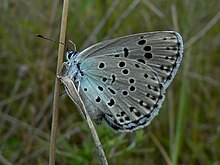Phengaris arion
| Large blue | |
|---|---|
 |
|
| Upperside | |
 |
|
| Underside | |
| Scientific classification | |
| Kingdom: | Animalia |
| Phylum: | Arthropoda |
| Class: | Insecta |
| Order: | Lepidoptera |
| Family: | Lycaenidae |
| Genus: | Phengaris |
| Species: | P. arion |
| Binomial name | |
|
Phengaris arion (Linnaeus, 1758) |
|
 |
|
| Synonyms | |
|
|
The large blue (Phengaris arion) is a species of butterfly in the Lycaenidae family. The species was first defined in 1758 and first discovered in Britain in 1795. In 1979 the species became extinct in Britain but has been successfully reintroduced with new conservation methods. Currently large blue is classified as "near threatened" on the IUCN Red List of Threatened Species. Today P. arion can be found in Europe, the Caucasus, Armenia, western Siberia, Altai, north-western Kazakhstan and Sichuan.
The large blue can be distinguished by its unique speckled black dots on its wings with a blue background.
The large blue butterfly is well known among the behavioural ecology field as it exhibits a unique parasitic relationship with a single species of red ant, Myrmica sabuleti. The species also feeds on thyme and wild marjoram oregano as food plants early in its life cycle.
Large blue caterpillars are about half an inch (13 millimetres) in length, and can live as long as 9 months before they form a chrysalis to become a butterfly. Large blue butterflies have a wingspan of up to 2 inches (50.8 millimetres), and will live for only a few weeks. The wings of the large blue butterfly are speckled with black dots. Compared with a large blue caterpillar, the adult's lifespan is short.
The large blue butterfly is found from coast to coast of the Palearctic realm, but is most concentrated in the areas from France to China.
The habitat of the large blue butterfly is largely influenced by location of its food sources. The species requires a combination of abundant amounts of its larval food plant, Thymus drucei and the presence of Myrmica sabuleti ants in order to survive.
...
Wikipedia

